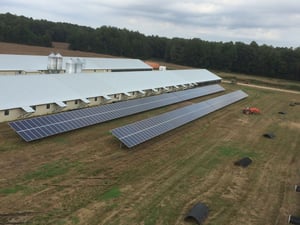How To Install A Ground Mount Solar System
Are you thinking about installing a solar energy organisation? If so, congratulations on taking the first step towards gaining control of your electric pecker and shrinking your carbon footprint! This ane investment can bring decades of gratuitous electricity, substantial tax savings, and helps you brand a divergence in the environment and your financial future. But before you swoop in, you'll want to determine what kind of solar arrangement you should install. And by that, we mean a roof-mount system or a ground-mountain organisation. In that location are pros and cons to both methods, so the all-time pick will depend on your situation. If y'all're thinking virtually installing a ground-mount organization, at that place are five things you need to know first. Standard-Mounted Panels When y'all think of basis-mounted solar panels, an image of a standard footing-mountain system is probably what pops into your mind. Metallic poles are drilled deep into the ground with a post pounder to securely ballast the system. Then, a framework of metal beams is erected to create the supporting structure on which the solar panels are installed. Standard ground-mountain systems stay at a fixed angle throughout the day and seasons. The degree of tilt to which the solar panels are installed is an important cistron, as information technology impacts how much electricity the panels will generate. Additionally, the direction the panels face will too take an impact on production. South-facing panels will receive more sunlight than north-facing panels. A standard ground-mount organisation should be designed to maximize exposure to sunlight and installed at the optimal tilt angle to maximize electricity output. This angle will vary with geographic location. Pole-Mounted Tracking Organisation The sun doesn't stay in one place throughout the day or the twelvemonth. That means a organization installed at a fixed angle (standard-mounted system) will produce less energy than a organization that is dynamic and adjusts the tilt along with the sun'southward daily and yearly movement. This is where pole-mounted solar systems come in. While maximizing the productivity of your system sounds similar an all-effectually win, there are a few things to know. Tracking systems require a more than circuitous set upwardly and depend on more mechanics. This means they will cost more than coin to install. On top of the added costs, pole-mounted tracking systems can require more than maintenance. While this is a well-developed and trusted technology, tracking systems take more moving parts, so at that place's going to be a college risk of something going wrong or falling out of place. With a standard footing mount, this is much less of a business concern. In some situations, the additional electricity generated by the tracking arrangement may compensate for the added price, simply this will vary on a case-past-case basis. Bonus: Carport Solar Systems A solar carport is a variation of the standard ground mountain. Instead of existence lower to the ground, the panels are suspended loftier enough to shelter vehicles. Carports are typically installed over parking lots or in driveways, providing parked cars protection from the elements and providing the possessor with cost- and emissions-free electricity. Solar carports help optimize otherwise underutilized space and tin can be a cracking place to install electric vehicle charging stations. That said, considering they need to be college off the ground than a typical standard ground mount, they will cost more to install. Compared to a roof-mounted solar system, ground mounts will most probable be the more expensive option, at least in the short term. Basis-mount systems require more labor and more materials. While a roof mountain still has a racking system to hold the panels in place, its main support is the roof on which it'due south installed. With a footing-mountain organization, your installer needs to get-go cock the sturdy support structure with steel beams drilled or pounded deep into the basis. But, while the installation cost may be higher than a roof mount, that doesn't mean information technology's the best choice long term. With a roof mount, you lot're at the mercy of your roof, which may or may not be suitable for solar. Some roofs may not be able to support the boosted weight of a solar system without reinforcements, or you lot may need to replace your roof. Additionally, a north-facing roof or a heavily shaded roof can severely reduce the amount of electricity your system generates. These factors could brand a ground-mounted solar arrangement more appealing than a roof-mounted organisation, despite the increased installation price. Compared to a roof mount, a footing-mounted arrangement may produce more free energy per watt of solar installed. Solar systems are more efficient the cooler they are. With less oestrus present, there volition be less friction as the free energy transfers from the solar panels to your home or business. Solar panels installed on roofs sit down merely a few inches higher up the roof. On sunny days, roofs unobstructed past any type of shade can warm up quickly. In that location is little space below the solar panels for ventilation. With a basis mount, however, there will exist a few feet betwixt the bottom of the solar panels and the ground. Air can flow freely betwixt the basis and the panels, helping to keep the temperature of the solar system lower, thus helping them be more efficient. In addition to a slight boost in product from cooler temperatures, yous'll too have more than freedom when it comes to where you'll install your system, the direction it faces, and the panels' degree of tilt. If optimized, these factors can provide gains in productivity over a roof-mount system, especially if your roof is poorly situated for solar. Y'all'll want to cull a spot that's free of shade from nearby copse or buildings, and preferably orient the organisation s. South-facing systems will receive the nearly sunlight throughout the day. Additionally, your installer tin can blueprint the racking organisation to tilt at the optimal degree for your location. With a roof-mounted system, your solar system's tilt is restricted by the pitch of your roof. While ground-mount systems allow you to choose the all-time place to install your solar system in regards to production, y'all need to dedicate that area to the solar system. The amount of state volition vary with the size of your solar system. A typical dwelling house with a $120/month electric neb would probable need a 10 kW system. A system of this size would cover roughly 624 square feet or .014 acres. If you lot accept a subcontract or business organisation, your electrical bill is probably much college, and yous'd need a bigger solar organization. A 100 kW system would cover a $ane,200/month electric neb. This system would span roughly eight,541 square anxiety or about .2 acres. Solar systems will last decades, with many high-quality brands offering warranties for 25 or even 30 years. Keep this in mind when selecting where your organisation volition get. Brand sure you don't have time to come plans for that area. Especially for farmers, giving up country ways giving up income. In some cases, y'all tin install a ground-mounted organization that'due south several feet higher off the ground. This can allow the clearance required for growing crops underneath the panels. However, this will come up with an added cost, which should exist weighed against the turn a profit of those crops. Regardless of how much space is below the panels, you'll have to maintain whatever vegetation that grows around and underneath the arrangement. Yous may also demand to consider security fencing around the system, which volition require additional space. Fences need to be installed a rubber distance in front end of the panels to prevent shading bug on the panels. Basis-mounted panels will be easier to access over panels installed on rooftops. This can come in handy should you need maintenance or repairs for your panels. It'll exist easier for solar technicians to access ground mounts, which tin help go along costs downward. That said, footing mounts also make it easy for unauthorized people and animals to access your system. Anytime at that place is intense pressure on the panels, whether it be from climbing on them or hitting them, it can accelerate the deposition of your panels, and curious animals may even chew on wiring. Oftentimes, solar owners will install a fence effectually their ground mount system to continue out unwanted visitors. In fact, this may be a requirement, depending on your system'southward size and the local rules. The need for a fence will be adamant during the permitting procedure or during the inspection of your installed solar system. Ground-mounted solar systems are a great pick for those interested in going solar. While they may cost a bit more than than a roof-mount system, basis-mount systems give you more liberty on the location and placement of the solar panels. They can be designed and installed for optimal product, instead of being limited to the pitch and direction of your roof. That said, yous'll desire to be certain at that place is an appropriately sized slice of land available to install the organization that gets plenty of sunlight and be prepared to contend in and maintain the vegetation around the organisation. What you should know before installing a solar ground mount
ane. There are Two Types of Ground-Mount Systems

![]() Pole mounted systems (besides known as Solar Trackers) make use of ane main pole drilled into the ground, which volition hold up several solar panels. Pole mounts are often installed with a tracking system, which will move your solar panels throughout the day to maximize exposure to the sun, thus maximizing their electricity production. They can rotate the direction they're facing, likewise as adjust the angle in which they're tilted.
Pole mounted systems (besides known as Solar Trackers) make use of ane main pole drilled into the ground, which volition hold up several solar panels. Pole mounts are often installed with a tracking system, which will move your solar panels throughout the day to maximize exposure to the sun, thus maximizing their electricity production. They can rotate the direction they're facing, likewise as adjust the angle in which they're tilted. 2. Ground-Mount Solar Systems Are Typically More than Expensive
3. Footing-Mounted Solar Panels May Be Slightly More Efficient
iv. You'll Have to Set Aside a Portion of Land for the Ground-Mountain System

v. Ground Mounts Are Easier to Admission - Which is Both Practiced and Bad
Should You Install a Ground-Mounted Organisation?

Source: https://www.paradisesolarenergy.com/blog/5-things-to-know-before-you-install-a-ground-mounted-solar-system
Posted by: donaldsonherry1947.blogspot.com


0 Response to "How To Install A Ground Mount Solar System"
Post a Comment